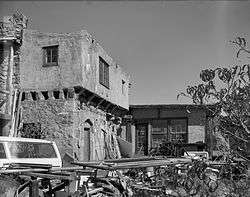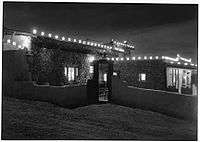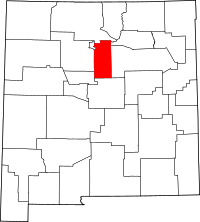Seton Village
|
Seton Village | |
 House at Seton Village | |
  | |
| Nearest city | Santa Fe, New Mexico |
|---|---|
| Coordinates | 35°35′56″N 105°55′54″W / 35.59889°N 105.93167°WCoordinates: 35°35′56″N 105°55′54″W / 35.59889°N 105.93167°W |
| Area | 43.7 acres (17.7 ha) |
| Built | 1946 |
| NRHP reference # | 66000492[1] |
| NMSRCP # | 119 |
| Significant dates | |
| Added to NRHP | October 15, 1966 |
| Designated NHLD | December 21, 1965[2] |
| Designated NMSRCP | May 18, 1973 |
Seton Village is a National Historic Landmark District in a rural residential area south of Santa Fe in Santa Fe County, New Mexico. It encompasses a residential settlement and educational facility established in 1930 by Ernest Thompson Seton (1860-1946), an educator and conservationist best known as a founder of the Boy Scouts of America. The district includes the remains of Seton's 32-room home and other residential and educational buildings constructed mostly between 1930 and 1945. It was declared a National Historic Landmark in 1965.[2][3]
Description
Seton Village is located about 7 miles (11 km) south of downtown Santa Fe and west of Interstate 25 on County Road 58. The village has a central plaza, around which adobe residences and community buildings. To the east of the plaza stand the remains of Seton's 32-room castle, which burned during restoration in 2005. Distinctive structures in the village include two building that were built around railroad cars that Seton brought to the site. Stripped over their interiors, the hoe finished plaster on the inside, and had adobe walls built around them. One of these buildings has since had the car removed from its inside.[3]
Seton Castle

Seton began designing and building his castle in 1933. The 32-room, 6,900 square foot (640 m2) multi-level building had a flat-roof and rough hewn stone wall exterior. The interior had oak floors and plaster walls with the ceilings supported by log rafters. The Castle was built on one of the highest points on Seton's property, with views over his village and the western landscape.
Community activities
The Village was home to the Seton Institute, including the Woodcraft League and the College of Indian Wisdom, which provided Woodcraft and Scouting leaders with a variety of training opportunities. The Institute closed at the outbreak of World War II.
At Seton's invitation, Maurice and Marceil Taylor moved their printing equipment to New Mexico in 1938 and set up the Seton Village Press. The Village Press closed in 1943, also because of the war.
Seton Village today
Seton Village is designated a National Historic Landmark and a New Mexico State Cultural Property. The Academy for the Love of Learning, an educational organization which owns the property, preserved the castle ruins as a "contemplative garden."[4] The Academy's Seton Legacy Project maintains a collection of art and archives pertaining to Ernest Thompson Seton. The Academy Campus, including the Seton art gallery, opened in 2011.[5]
The village has a view of the Jemez Mountains and Mount Taylor.
See also
References
- ↑ National Park Service (2010-07-09). "National Register Information System". National Register of Historic Places. National Park Service.
- 1 2 "National Historic Landmarks Survey, New Mexico" (PDF). National Park Service. Retrieved January 7, 2017.
- 1 2 Richard Greenwood (November 14, 1975). "National Register of Historic Places Inventory-Nomination: Seton Village" (pdf). National Park Service. and Accompanying nine photos from 1974 (32 KB)
- ↑ Tom Sharpe (October 10, 2010). "Seton Castle: An academy rises from the ruins". The Santa Fe New Mexican. Archived from the original on February 2, 2013. Retrieved May 21, 2012.
- ↑ Sharpe, Tom. "Seton Castle: An academy rises from the ruins", The Santa Fe New Mexican, Santa Fe, NM, 10 October 2010. Retrieved on 01 November 2012.
External links
| Wikimedia Commons has media related to Seton Village, New Mexico. |
- Historic American Buildings Survey (HABS) No. NM-182-A, "Indian Village, Ernest Thompson Seton House, Six miles southeast of Santa Fe, off U.S. Route 84-85, Seton Village, Santa Fe County, NM"
- Academy for the Love of Learning
- Seton Village site at the NPS
- Ernest Thompson Seton Institute
- http://www.stateparks.com/seton_village.html
- Seton Village Press
